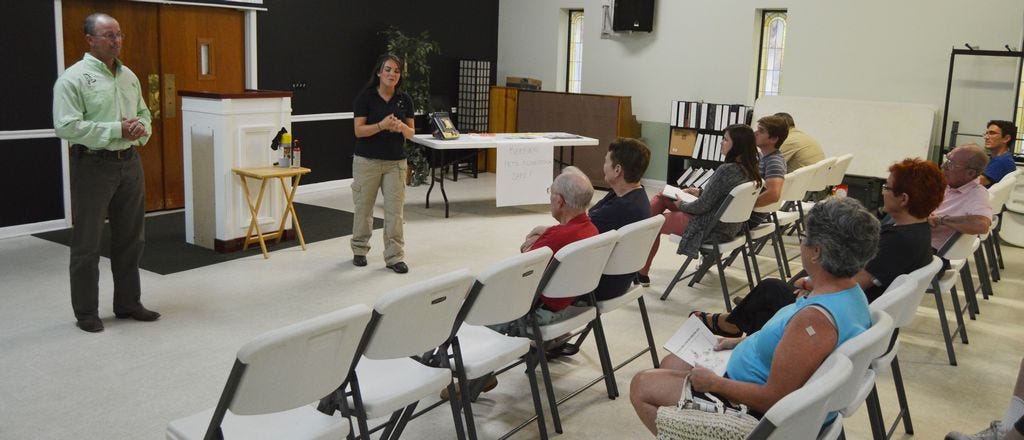
NAVARRE — While one goal behind this week’s bear workshop in Navarre was to educate and offer solutions to Santa Rosa County residents who encounter black bears, event organizers also wanted to encourage advocacy for finding common ground when dealing with the protected animals.
GALLERY: Photos from Tuesday night's Bear Workshop in Navarre>
“Society has to tell us that this is too many bears, there (are) too many conflicts, too many people getting hurt,” said Steve Shea, director of the Florida Fish and Wildlife Conservation Commission’s northwest region. “Your voices, whether they are for or against hunting, that needs to be heard both politically and socially.”
The meeting at First Baptist Church of Navarre, hosted by commission officials and Rep. Doug Broxson, allowed residents to voice their concerns.
WATCH: FWC officials address attendee's concerns regarding black bear issues>
Midway residents Doug and Donna Smith, who live in the Lighthouse Pointe neighborhood, said they have encountered black bears near their home on more than one occasion.
“They are very tame animals,” Donna Smith said. “The problem is a lot of people in our neighborhood have bird feeders, and there is also a lady that feeds feral cats, so we are never going to get rid of the bears.”
Smith said the bear population is growing around the area to the point where a hunting season should be initiated.
“It would be nice if they could do something about this,” she said.
While the FWC has postponed bear hunting for 2016, other suggestions mentioned by attendees including moving the bears elsewhere or altering bears to control the population.
Residents can do their part, the presenters said.
Shea and Kaitlin Goode, an area bear biologist, stressed that household trash is attractive to bears.
“More than 75 percent of our calls have something to do with garbage,” Goode said.
While encouraging residents to not put their trash beside the road until the morning of trash retrieval, Goode also suggested securing trash cans with locks or building a structure to secure trash cans from bears.
Goode also championed government involvement, namely with an ordinance requiring residents to secure their trash containers until the morning of pick-up. Seminole County passed a similar ordinance with successful results, she said.
Goode said public input to local leaders can make such a preventive measure become a reality.
“(As for a) Santa Rosa specific garbage ordinance, we have met with the county commission and they are interested in doing it, and so it is just a matter of us following up with them and making sure they are taking those steps,” she said.
“If you guys are interested in having that done, that is something they need to hear from you.”
DID YOU KNOW?
●During the summer, a black bear eats up to 5,000 calories a day. During the fall, it consumes up to 20,000 calories a day.
●15 people have been injured by bears in Florida
●More than 75 percent of Florida’s bear-related calls are trash related
●50 percent of bears repeat an offense after being moved by wildlife officials; 70 percent return or wander to the area they were removed from
●In 1974, black bears were listed as a state threatened species. In 1994 the state was closed to all bear hunting. In 2012, black bears were removed from the state’s threatened species list.
●There are an estimated 140 black bears in the West Panhandle Region of Florida, which is a 75 percent increase compared to populations between 2002 and 2014/2015. Over the entire state has seen an increase of 60 percent, totaling 4,350 black bears throughout Florida.
Source: The Florida Fish and Wildlife Conservation Commission
HOW TO HELP
To report human-bear conflicts, contact the Panama City-based Florida Fish and Wildlife and Conservation Commission office at 265-3676
This article originally appeared on Santa Rosa Press Gazette: Wildlife officials, residents seek solutions for human-bear encounters (VIDEOS, PHOTOS)
